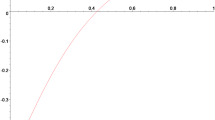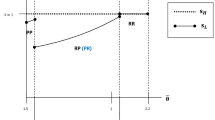Abstract
In this paper, we consider that the public firm competes with a private firm caring about consumer surplus in vertically differentiated market. We explore the privatization policy, and the relationship between the optimal degree of privatization and the CSR degree of private firm. We find that if the public firm produces low-quality products, the government should adopt a policy of privatization, and the optimal degree of privatization is decreasing (increasing) in the CSR degree of private firm, if the cost difference of quality is sufficiently small (large). However, if the public firm produces high-quality products and the cost difference of quality is sufficiently large (small), the government should (not) adopt a policy of privatization. The government's privatization policy is related to the difference in quality and cost of the products produced by firms. We further analyze the endogenous selection of product quality between public firm and private firm and find that if the quality gap between high-quality products and low-quality products is sufficiently large, both firms will choose to produce high-quality products. If the product quality gap is of medium-intensity, the public firm chooses to produce low-quality products, and the private firm chooses to produce high-quality products. However, if the product quality gap is sufficiently small, there is no Nash equilibrium.

Similar content being viewed by others
Notes
Reviewing the history of CSR development, however, CSR efforts emerged not because of their completely voluntary, but rather out of a variety of social, environmental, and economic pressures (European Commission 2001).
See Li et al. (2019), in particular, in an import-competing duopoly model with vertical product differentiation, the tariff will decrease if the foreign firm switches from a purely profit-driven firm to a CSR firm. A consumer-oriented CSR strategy will always hurt the domestic firm’s profit, whereas the relationship between the foreign firm’s profit and CSR sensitivity (the degree to which a firm care about consumer welfare) is inversely U-shaped.
Our research provides a rich framework. If the CSR behavior of private firm is not considered, our model can be degenerated to examine the impact of vertical product differentiation on privatization policy.
Thanks to the reviewers and the editor for their comments and suggestions of doing this extension, which have substantially improved the analysis of this paper.
The forms of \(\Phi^{HH} (\alpha ,\delta )\) and \(\Psi^{HH} (\alpha ,\delta )\) are complicated, which we show in the Appendix.
The forms of \(\Phi^{HL} (\alpha ,\delta )\) and \(\Psi^{HL} (\alpha ,\delta )\) are complicated, which we show in the Appendix.
The forms of \(\Phi^{LH} (\alpha ,\delta )\) and \(\Psi^{LH} (\alpha ,\delta )\) are complicated, which we show in the Appendix.
Thanks to the comments of a reviewer, it deserves for further analysis in future studies.
References
Arora, S., & Gangopadhyay, S. (1995). Toward a theoretical model of voluntary overcompliance. Journal of Economic Behavior and Organization, 28(3), 289–309.
Bárcena-Ruiz, J. C., Dong, Q., & Wang, L. F. S. (2020). Foreign-owned firms and partial privatization of state holding corporations. Japanese Economic Review, 71(2), 287–301.
Benassi, C., Castellani, M., & Mussoni, M. (2016). Price equilibrium and willingness to pay in a vertically differentiated mixed duopoly. Journal of Economic Behavior and Organization, 125, 86–96.
Brand, B., & Grothe, M. (2015). Social Responsibility in a Bilateral Monopoly. Journal of Economics, 115(3), 275–289.
Calveras, A., & Ganuza, J. (2018). Corporate social responsibility and product quality. Journal of Economics and Management Strategy, 27(4), 804–829.
Chang, Y. M., Chen, H. Y., Wang, L. F. S., & Wu, S. J. (2014). Corporate social responsibility and international competition: A welfare analysis. Review of International Economics, 22(3), 625–638.
Chao, A. C., Lee, J. Y., & Wang, L. F. S. (2016). Corporate social responsibility, trade liberalization and global welfare”. In S. Pauline (Ed.), Trade liberalization: global policies, benefits and economic risks (pp. 25–36). New York: Nova Science Publishers.
Chen, C. L., Liu, Q., Li, J., & Wang, L. F. S. (2016). Corporate social responsibility and downstream price competition with retailer's effort. International Review of Economics and Finance, 46, 36–54.
De Fraja, G., & Delbono, F. (1989). Alternative strategies of a public enterprise in oligopoly. Oxford Economic Papers, 41, 302–311.
Doni, N., & Ricchiuti, G. (2013). Market equilibrium in the presence of green consumers and responsible firms: A comparative statics analysis. Resource and Energy Economics, 35(3), 380–395.
European Commission. (2001). “Green Paper: Promoting a European Framework for Corporate Social Responsibility”, Commission of the European Communities.
Fanti, L., & Buccella, D. (2017a). The effects of corporate social responsibility on entry. Economia E Politica Industriale, 44(2), 259–266.
Fanti, L., & Buccella, D. (2017b). Corporate social responsibility in a game-theoretic context. Economia E Politica Industriale, 44(3), 371–390.
Fanti, L., & Buccella, D. (2017c). Corporate social responsibility, profits and welfare with managerial firms. International Review of Economics, 64(4), 341–356.
Filippini, L., & Vergari, C. (2017). Vertical integration smooths innovation diffusion. The B E Journal of Economic Analysis and Policy, 17(3), 1–22.
Fujiwara, K. (2007). Partial privatization in a differentiated mixed oligopoly. Journal of Economics, 92(1), 51–65.
García-Gallego, A., & Georgantzís, N. (2009). Market effects of changes in consumers' social responsibility. Journal of Economics and Management Strategy, 18(1), 235–262.
Gil-Moltó, M. J., Poyago-Theotoky, J., Rodrigues-Neto, J. A., & Zikos, V. (2019). Mixed oligopoly, cost-reducing research and development, and privatization. European Journal of Operational Research, 283, 1094–1106.
Goering, G. E. (2007). The strategic use of managerial incentive in a non-profit firm mixed duopoly. Managerial and Decision Economics, 28(2), 83–91.
Goering, G. E. (2008). Socially concerned firms and the provision of durable goods. Economic Modelling, 25(3), 575–583.
Goering, G. E. (2012). Corporate social responsibility and marketing channel coordination. Research in Economics, 66(2), 142–148.
Goering, G. E. (2014). The profit-maximizing case for corporate social responsibility in a bilateral monopoly. Managerial and Decision Economics, 35(7), 493–499.
Kalashnikov, V. V., Bulavsky, V. A., Kalashnykova, N. I., & Castillo, F. J. (2011). Mixed oligopoly with consistent conjectures. European Journal of Operational Research, 210(3), 729–735.
Kim, S. L., Lee, S. H., & Matsumura, T. (2019). Corporate social responsibility and privatization policy in a mixed oligopoly. Journal of Economics, 128(1), 67–89.
Kopel, M. (2015). Price and quantity contracts in a mixed duopoly with a socially concerned firm. Managerial and Decision Economics, 36(8), 559–566.
Kopel, M., & Brand, B. (2012). Socially responsible firms and endogenous choice of strategic incentives. Economic Modelling, 29(3), 982–989.
Lambertini, L., Palestini, A., & Tampieri, A. (2016). CSR in an asymmetric duopoly with environmental externality. Southern Economic Journal, 83(1), 236–252.
Lee, S. H., & Tomaru, Y. (2017). Output and R&D subsidies in a mixed oligopoly. Operations Research Letters, 45(3), 238–241.
Li, J., Wang, X., Dong, B., & Yu, E. S. H. (2019). Corporate Social responsibility, vertical product differentiation and international competition. Review of International Economics, 27(4), 1108–1125.
Liu, C. C., Wang, L. F. S., & Lee, S. H. (2015). Strategic environmental corporate responsibility in a differentiated duopoly market. Economics Letters, 129, 108–111.
Liu, Q., Wang, L. F. S., & Chen, C. (2018). CSR in an oligopoly with foreign competition: policy and welfare implications. Economic Modelling, 72, 1–7.
Liu, Q., Wang, L. F. S., Chen, C., & L., (2019). Upstream privatization in mixed market with retailer’s efforts. North American Journal of Economics and Finance, 48, 338–345.
Manasakis, C., Mitrokostas, E., & Petrakis, E. (2013). Certification of corporate social responsibility activities in oligopolistic markets. Canadian Journal of Economics, 46, 282–309.
Manasakis, C., Mitrokostas, E., & Petrakis, E. (2018). Strategic corporate social responsibility by a multinational firm. Review of International Economics, 26, 709–720.
Matsumura, T. (1998). Partial privatization in a mixed duopoly. Journal of Public Economics, 70, 473–483.
Matsumura, T., & Ogawa, A. (2014). Corporate social responsibility or payoff asymmetry? A study of an endogenous timing game. Southern Economic Journal, 81(2), 457–473.
Nett, L. (1993). Mixed oligopoly with homogeneous goods. Annals of Public and Cooperative Economics, 64(3), 367–393.
Ouattara, K. S. (2017). Strategic privatization in a mixed duopoly with a socially responsible firm. Economics Bulletin, 37(3), 2067–2075.
Planer-Friedrich, L., & Sahm, M. (2020). Strategic corporate social responsibility, imperfect competition, and market concentration. Journal of Economics, 129(1), 79–101.
Tomaru, Y., & Wang, L. F. S. (2018). Optimal privatization and subsidization policy in mixed oligopoly: Relevance of an efficiency gap. Journal of Institutional and Theoretical Economics, 174, 189–203.
Wang, L. F. S., Wang, Y. C., & Zhao, L. (2012). Tariff policy and welfare in an international duopoly with consumer-friendly initiative. Bulletin of Economic Research, 64(1), 56–64.
Acknowledgements
Financial support from Guangdong Basic and Applied Basic Research Foundation (2019A1515110690), is greatly appreciated. We are grateful to the Editor and two anonymous referees for comments that helped us to improve the paper.
Author information
Authors and Affiliations
Corresponding author
Additional information
Publisher's Note
Springer Nature remains neutral with regard to jurisdictional claims in published maps and institutional affiliations.
Appendix
Appendix
-
①
\(\Phi^{{{\text{HH}}}} (\alpha ,\delta )\) and \(\Psi^{{{\text{HH}}}} (\alpha ,\delta )\):
$$\Phi^{HH} (\alpha ,\delta ) = \frac{{(1 + \delta )\left( \begin{gathered} 60536 + 144\alpha^{8} \delta (1 + \delta )^{8} + H_{1} (\alpha ,\delta ) + H_{2} (\alpha ,\delta ) - H_{3} (\alpha ,\delta ) + \hfill \\ H_{4} (\alpha ,\delta ) - 2\alpha^{2} (1 + \delta )^{2} H_{5} (\alpha ,\delta ) - \alpha (1 + \delta )H_{6} (\alpha ,\delta ) + H_{7} (\alpha ,\delta ) \hfill \\ \end{gathered} \right)}}{{\left( \begin{gathered} (36(3 - \alpha + (2 - \alpha )\delta )^{3} (5 - \alpha (1 + \delta )(3 + \delta ) + \delta (5 + \delta )) \hfill \\ (14 + 2\alpha^{2} (1 + \delta )^{2} - 2\alpha (1 + \delta )(4 + 3\delta ) + \delta (22 + \delta (10 + \delta )))^{2} ) \hfill \\ \end{gathered} \right)}}$$
where
-
②
\(\Phi^{{{\text{HL}}}} (\alpha ,\delta )\) and \(\Psi^{HL} (\alpha ,\delta )\):
$$\Phi^{{{\text{HL}}}} (\alpha ,\delta ) = \frac{{\left( \begin{gathered} (1 + \delta )24\alpha G_{1} (\alpha ,\delta )\delta^{2} + G_{2} (\alpha ,\delta )\delta^{3} + G_{3} (\alpha ,\delta )\delta^{4} - 4G_{4} (\alpha ,\delta ) + 2G_{5} (\alpha ,\delta )\delta^{6} + \hfill \\ 2G_{6} (\alpha ,\delta )\delta^{7} + 2G_{7} (\alpha ,\delta )\delta^{8} - (3 - \alpha )G_{8} (\alpha ,\delta )\delta^{9} - G_{9} (\alpha ,\delta )\delta^{10} - G_{10} (\alpha ,\delta )\delta^{11} - \hfill \\ 2(3 - \alpha )^{7} (518 - \alpha (293 - 44\alpha ))\delta^{12} - 12(3 - \alpha )^{9} \delta^{13} ) \hfill \\ \end{gathered} \right)}}{{\left( \begin{gathered} (17 - (8 - \alpha )\alpha )\delta^{2} - 36(3 - \alpha )^{3} \delta (1 + \delta )^{2} (2\alpha + (7 + (2 - \alpha )\alpha )\delta + \hfill \\ (3 - \alpha )^{2} \delta^{3} )(6 + \delta (22 - 6\alpha + 2(13 - (7 - \alpha )\alpha )\delta + (3 - \alpha )^{2} \delta^{2} ))^{2} \hfill \\ \end{gathered} \right)}},$$
where
where
-
③
\(\Phi^{LH} (\alpha ,\delta )\) and \(\Psi^{LH} (\alpha ,\delta )\):
$$\Phi^{LH} (\alpha ,\delta ) = \frac{{\left( \begin{gathered} N_{1} (\alpha ,\delta ) - N_{2} (\alpha ,\delta ) + N_{3} (\alpha ,\delta ) + N_{4} (\alpha ,\delta ) - 4\alpha^{5} \delta^{2} N_{5} (\alpha ,\delta ) - \hfill \\ 9\alpha (1 + \delta )N_{6} (\alpha ,\delta ) + 2\alpha^{4} \delta N_{7} (\alpha ,\delta ) + 6\alpha^{2} (1 + \delta )N_{8} (\alpha ,\delta ) - \alpha^{3} N_{9} (\alpha ,\delta ) \hfill \\ \end{gathered} \right)}}{{\left( \begin{gathered} 36\delta (3 - \alpha + (2 - \alpha )\delta )^{3} (2\alpha - (3 - (5 - \alpha )\alpha )\delta - \hfill \\ (3 - \alpha )(1 - \alpha )\delta^{2} )(6 + \delta (13 - 6\alpha - 2(2 - \alpha )^{2} \delta ))^{2} \hfill \\ \end{gathered} \right)}},$$
where
where
Rights and permissions
About this article
Cite this article
Wang, X., Wang, L.F.S. Corporate social responsibility, vertical product differentiation, and privatization policy. JER 73, 403–425 (2022). https://doi.org/10.1007/s42973-020-00053-9
Received:
Revised:
Accepted:
Published:
Issue Date:
DOI: https://doi.org/10.1007/s42973-020-00053-9
Keywords
- Vertical product differentiation
- Mixed oligopoly
- Corporate social responsibility
- Privatization policy
- Cost-difference quality




